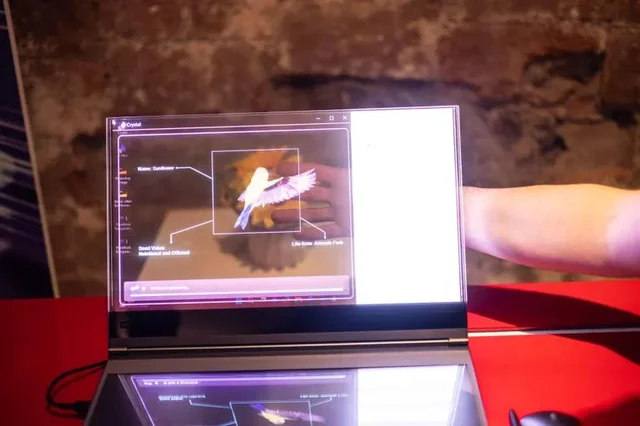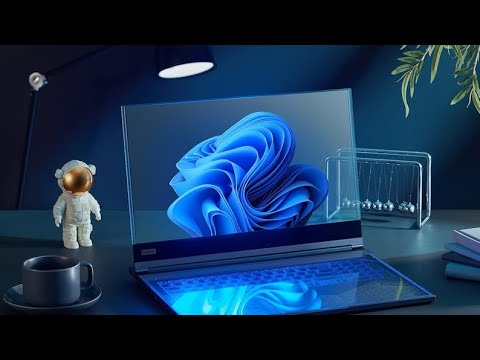Introduction
Lenovo has a reputation for pushing the boundaries of innovation, and with their recent transparent laptop concept, they’ve taken another bold step into the future of computing. This device seamlessly blends the physical world with the digital, offering a revolutionary new way to interact with technology.
The Design – Where Sci-Fi Meets Reality
At first glance, Lenovo’s transparent laptop might appear like something straight out of a science fiction blockbuster. Its most striking feature is the fully transparent display. Imagine a laptop screen that allows you to see the world behind it as if nothing were there.
Lenovo achieves this remarkable effect through a combination of cutting-edge technologies:
- Micro-LED Display: The display utilizes micro-LED technology. Compared to traditional OLED, micro-LEDs offer higher brightness, enabling superior visibility even in sunlight, and vastly improved power efficiency.
- **Transparency: ** The micro-LED display panel is incredibly thin, allowing for a high degree of transparency when pixels are not lit. Lenovo quotes around 55% transparency for this concept device.
- Virtual Keyboard & Touchpad: Since a physical keyboard and touchpad would obstruct the view, Lenovo employs a virtual keyboard and touchpad projected onto a flat surface in front of the display.

Functionality – Lenovo Redefining Laptop Interactions
Lenovo’s transparent laptop fundamentally changes how we work and interact with our devices. It promises to introduce us to a world of blended realities and enhance our creative processes. Here’s how:
- Augmented Reality (AR): The transparent laptop essentially becomes a portable augmented reality display. Imagine overlaying digital content onto your physical environment with applications ranging from:
- Navigation: GPS directions shown directly on the world in front of you
- Architecture & Design: Visualizing models or blueprints superimposed on the real world
- Education: Interactive 3D models floating in space for detailed exploration
- Gaming: Bringing digital game characters and objects into your physical space
- **Multitasking: ** The transparent display creates a sense of expanded workspace. Picture this:
- Presentations: Deliver presentations with your visual aids clearly visible alongside your face for a more engaging audience interaction
- Content Creation: Edit videos and photos while seeing a reference document behind the editing software window.
- Collaboration: Brainstorm or work on shared documents with collaborators seeing the screen from either side.
- Situational Awareness: Imagine being engrossed in a movie or browsing the web while still maintaining visual awareness of your surroundings. This could be useful in a variety of situations.
Technical Innovations – Pushing the Boundaries
Several technological hurdles were overcome to bring Lenovo’s transparent laptop concept to life:
- Power Management: Micro-LED technology is vastly more energy-efficient than traditional display technologies, a crucial requirement for battery-powered devices.
- Heat Dissipation: The compact design of laptops poses challenges in managing heat. Transparent components necessitate innovative heat sink designs to efficiently cool the internal components.
- Object Recognition & AI: Lenovo envisions a camera strategically placed on the back that would utilize AI to recognize objects behind the screen. For example, imagine identifying a plant behind the display and having the laptop pull up botanical information with overlays on the live images.
Potential Use Cases – Beyond the Everyday
While Lenovo’s transparent laptop still exists primarily as a concept, it shows immense potential for various specialized applications:
- Design & Engineering: Architects could visualize structures on construction sites, and engineers could interact with detailed 3D models more intuitively.
- Retail and Showrooms: Product information and interactive displays can be overlaid in front of physical products, making shopping experiences more engaging.

- Healthcare: Doctors could display patient information and medical scans with greater contextualization in a surgical setting.
- Education: Students could learn complex subjects through interactive visualizations and simulations laid over the real world.
- Art and Creativity: Artists could trace physical artwork or use the transparent screen as a unique canvas for digital creations.
Challenges and Considerations – The Road Ahead
Before transparent laptops become mainstream, a few hurdles need to be addressed:
- Viewing in Bright Environments: Even with micro-LED’s higher brightness, visibility in extremely bright outdoor environments could be a challenge.
- Privacy: Overlaying private information on the real world may necessitate additional measures to protect sensitive data.
- User Interface: New input and interaction paradigms will be necessary to fully leverage the transparent display and AR functionality.
- Cost: Initially, these devices will likely be expensive due to the cutting-edge technology involved.
Also Read: Samsung’s Creating 1st Transparent Smartphone: A Look-Through Technology




